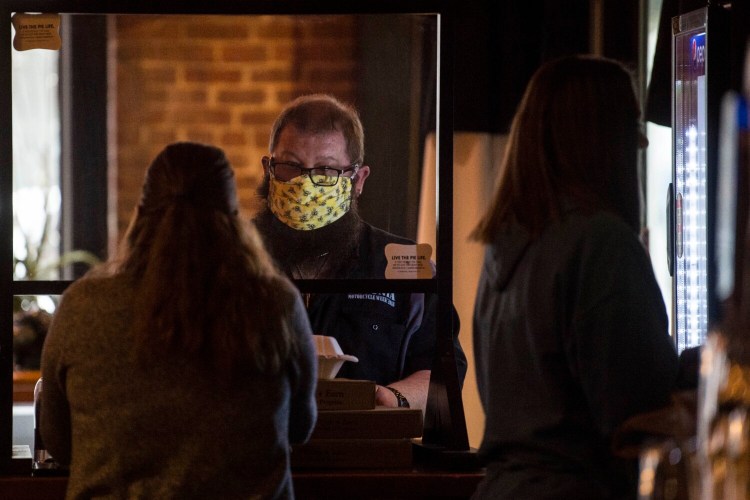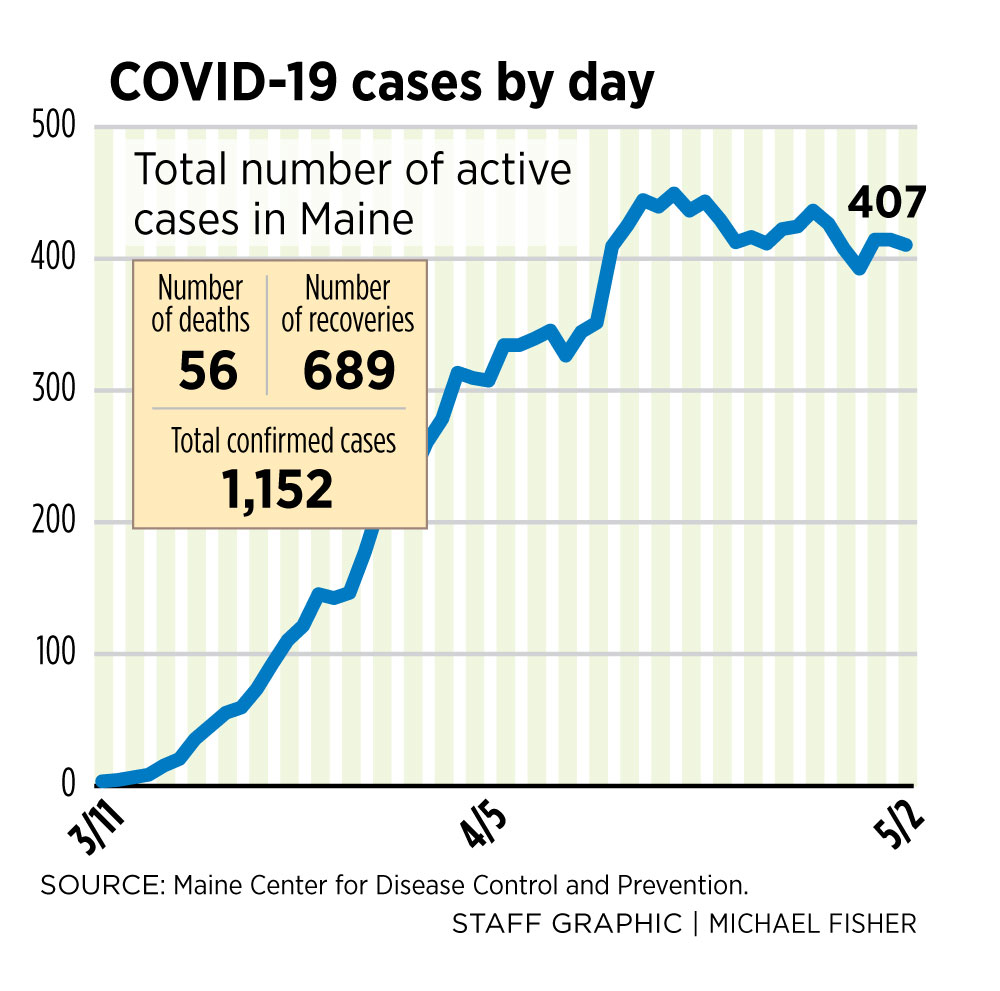The Maine Center for Disease Control and Prevention on Saturday reported 29 new cases of the novel coronavirus and one more death, raising the statewide totals to 1,152 cases and 56 deaths.
Subtracting numbers of patients who have recovered – 689 – and died, there were 407 active cases on Saturday.
The deceased person was a woman over the age of 80 who was living in the Tall Pines retirement community in Belfast, the Maine CDC said.
The death, and the small rise in cases, come as Mainers debate how best – and especially how fast – to reopen the state’s economy.
Select businesses around Maine reopened on Friday, provided they met state guidelines for safety. Hair salons, pet groomers, auto dealerships and others were swarmed with demand. Some businesses had schedules booked weeks out.
Despite easing restrictions in some areas, Gov. Janet Mills announced this past week that Mainers would be required to wear masks or cloth face coverings in public areas where social distancing is difficult, such as the grocery store. The executive order took effect Friday.
Simultaneous economic and public health concerns have led Mills to defend her handling of the crisis from both sides. She’s trying to address worries that businesses are reopening as Mainers with COVID-19 are still dying, but also that the economy isn’t starting up fast enough to save livelihoods.
This past week, a restaurant owner in Bethel announced he would defy Mills’s public health orders by opening for dine-in customers.
Sunday River Brewing Co. owner Rick Savage appeared on Fox News host Tucker Carlson’s show on Thursday to attack the governor, giving her cellphone number out on air. Late Friday afternoon, state officials entered the restaurant and seized Savage’s health license, also invalidating his liquor license and forcing him to capitulate.
The same day, Mills urged Mainers not to play politics with the pandemic.
“This virus plays no favorites: it doesn’t care whether you’re a Republican or a Democrat, a Green or an independent, unregistered or unenrolled. It does not take political sides; it is an equal opportunity destroyer,” the governor said Friday.
On Saturday in Augusta, more business owners protested the reopening plan, which they contend isn’t fast enough.
A Portland Press Herald/Maine Sunday Telegram analysis of infection data this past week suggested that social-distancing measures are working to slow the spread of COVID-19. Maine has among the lowest infection rates in the country, and is in the lower tier of deaths per 100,000 people.
As of Friday, there were 83.9 cases per 100,000 people in Maine, 138.3 in Vermont and 323.7 around the United States. New York state has the highest infection rate: 1,530.6 cases per 100,000 people.
Still, Maine is working with smaller numbers compared to more populous states, and so small fluctuations can have an outsize effect. And experts warn that, despite the progress the state has made, any undue relaxing of safety measures could let the virus come back.
Even as the overall outbreak appeared to be leveling off, certain communities in Maine were at higher risk. Long-term care facilities have seen a spate of outbreaks and deaths in recent weeks, and this past week, the Tyson Foods poultry processing plant in Portland reported that eight workers had tested positive for COVID-19, the disease caused by the coronavirus.
All 400 employees now are receiving tests. The company is also considering idling production as testing and safety measures take effect.
County by county on Saturday, there were 54 cases in Androscoggin County, five in Aroostook, 527 in Cumberland, 28 in Franklin, 10 in Hancock, 104 in Kennebec, 16 in Knox, 13 in Lincoln, 15 in Oxford, 82 in Penobscot, one in Piscataquis, 19 in Sagadahoc, 17 in Somerset, 49 in Waldo, two in Washington and 210 in York.
Public health officials have repeatedly cautioned that case numbers are likely being undercounted because of limited testing supplies. All Mainers should take precautions as though the virus is already in their surroundings, regardless of confirmed numbers, they say.
By age as of Saturday, only 2.3 percent of patients with COVID-19 in Maine were under 20, while 10.8 percent were in their 20s, 10.6 percent were in their 30s, 14.3 percent were in their 40s, 19.3 percent were in their 50s, 16.9 percent were in their 60s, 13.4 percent were in their 70s, and 12.5 percent were 80 or older.
Women continued to be infected at a higher rate than men, making up 53.4 percent of confirmed cases.
The Maine CDC periodically tracks numbers of negative tests for COVID-19 as well; as of the latest update, Wednesday, 19,546 people had tested negative.
The public health agency also has begun to report cases by race and ethnicity. The vast majority of confirmed patients are white – 731 – but there are also 41 patients identified as “black or African American,” one as “American Indian or Alaska Native,” 13 as “Asian or Pacific Islander,” and 23 as “Hispanic.” Eighteen cases are listed as “other” for race, and 250 patients did not disclose their race. Even more – 368 – did not disclose their ethnicity.
Maine’s hospital capacity was steady as of Saturday, with 160 intensive care unit beds available of a statewide 320. Nineteen of those beds were occupied by COVID-19 patients.
Ten COVID-19 patients were on ventilators Saturday. There were 290 ventilators available out of a statewide 315, and another 395 alternative ventilators approved by the Food and Drug Administration.
Send questions/comments to the editors.




Success. Please wait for the page to reload. If the page does not reload within 5 seconds, please refresh the page.
Enter your email and password to access comments.
Hi, to comment on stories you must . This profile is in addition to your subscription and website login.
Already have a commenting profile? .
Invalid username/password.
Please check your email to confirm and complete your registration.
Only subscribers are eligible to post comments. Please subscribe or login first for digital access. Here’s why.
Use the form below to reset your password. When you've submitted your account email, we will send an email with a reset code.